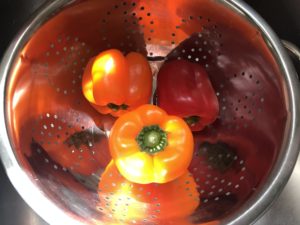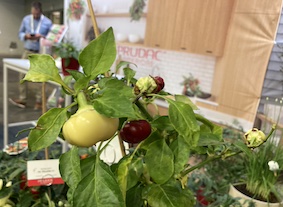Dealing with Pepper Maggots
Views: 17703

I’m a big fan of peppers, especially the red bell pepper. Chop them for salads, slice thin for a tuna salad sandwich, roast them over the gas stove flame to produce a slimy sweetness. Yum. Jalapeños are great, too, as are pablano and long sweet Italian peppers. Looking for variety, just look for different types of peppers.
Since I’ve been gardening in my community plot, I’ve never had great luck with bell peppers. Peppers would never fully turn red before they would begin to rot, still on the plant. And when it began to turn color, it was a funny purplish-brown red, the kind of brown that never is a good sign on a vegetable.
Not being a consistent applier of fertilizer, or, even during hectic times, not one to water consistently, I blamed the poor peppers on myself. Culturally, I was doing something wrong, I convinced myself. Fortunately, my few jalapeño and long sweet Italian plants produced some really nice peppers.
This year, a year I was determined to have success with everything I grew, my pepper problem returned. And it hasn’t been my doing, as far as I know. I fertilized well, especially early in the season. I’ve irrigated consistently. And still, the peppers turned purply brownish red and developed round spots of rot.
The sad situation changed slightly this year. Whatever was going wrong was going wrong with my jalapeños, too. With one or two hot peppers already rotten and thrown on the compost pile, I found one still on the plant that looked curious. It had a small pinhead-sized hole near the stem. That, I thought, was no cultural lack of care. That was a bug.
I quickly split open the still-small jalapeño to find one or two squirming white larva. This larva belongs to Zonosemata electa, or the Pepper Maggot.
What are Pepper Maggots?
The Pepper Maggot is a 2- to 3-inch-long fly with brown striped wings. It emerges from the ground around July in the Northeast and lays its eggs exclusively on young peppers, eggplants, and more rarely on tomatoes—all of which belong to the Solanaceae family.
If you look closely at the infected pepper, you may be able to see a small whitish dimple. That’s where the fly inserted its eggs. (Usually there is just one egg per pepper.)
The egg hatches into a larva after 8 to 10 days, and then eats its heart out inside the pepper. The larva turns from a pointy, white thing to a plump yellowy thing only its mother could love. After 18 days, the larva eats its way out of the pepper (the hole I saw) and drops onto the ground. It turns into a blackish, flat pupa in the top 5 inches of soil and will hang out there until it emerges as a fly the following summer.
Oh, the circle of life is grand, isnt it?
Repelling Maggots
Meanwhile, I’m left with Pepper Maggots eating my entire pepper crop. I can try to control the infestation by sprinkling very young fruits with diatomaceous earth, which will puncture the adult fly’s stomachs. I also can try to control the Pepper Maggot population for next year by removing and destroying the infected fruit before the suckers escape and tunnel into the soil to overwinter. This, though, will be difficult.
Since discovering Pepper Maggot in my own garden plot, I’ve talked with fellow community gardeners who have been wondering why their own peppers are rotting on the stem.
Maybe this is a crop I don’t try again next year.
Meet Ellen Wells
When you’re raised on a farm, you can’t help but know a thing or two about gardening. Ellen Wells is our expert on edible gardening.…
Ellen's Recent Posts

Spooky Red Pumpkin Pepper






